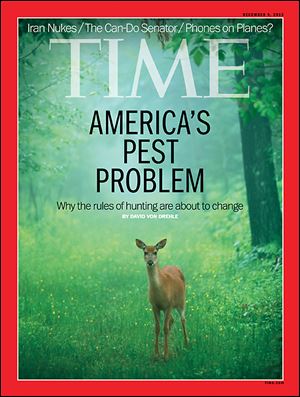
OUTDOORS
When wildlife numbers bring serious trouble, it’s time for more hunting
12/1/2013
Matt Markey
The Blade/Dave Zapotosky
Buy This Image

The cover of the current issue of Time magazine is not focused on the overwhelming human suffering in the aftermath of the typhoon in the Philippines, or on the cyber struggles of Obamacare, or the NFL’s uncomfortable internal examination of its ugly culture of 300-pound bullies.
Time chose to use the spotlight its lead story commands to make the case that increased hunting is the only viable means to control an overpopulation of wildlife that is an issue, a problem, or a crisis in many areas of America.
This publication, not known for being a vocal supporter of the tradition of hunting, apparently felt strongly enough about the growing number of clashes between man and beast to detail this perpetually hot-button topic.
Time says our conservation laws and restoration efforts have worked so well — too well in a number of cases — that we have warped the balance in the opposite direction. Species that were threatened with being wiped out in the last century are now so prolific that they can no longer be allowed to maintain their current numbers, without significant harm being done to both wildlife, and humans.
Writer David Von Drehle presents a very well-buttressed argument that the “environmental sensitivity” we learned from watching Bambi has made it extremely difficult to reach the conclusion that, with the absence of many real predators to control the populations, what we must do is remove “a bunch of these critters” from our surroundings.

The cover story for Time magazine from Dec. 9 focuses on the need for more hunting overpopulated species.
“It’s time to shake off sentimentality and see responsible hunting through 21st century eyes,” Von Drehle writes.
He states, and this should be shouted from the highest mountain tops, that today’s hunters should not be stained and judged by the gross transgressions of those that slaughtered wildlife in past centuries.
“By shouldering the role of careful, conservation-minded predators, hunters make the coexistence of humans and wildlife sustainable," Von Drehle writes.
The Time piece cites burgeoning numbers of deer, bears, raccoons, and other overpopulated wildlife as it lays out the issue.
The city council in a very progressive city such as Durham, N.C., has decided to utilize archery hunters inside the city limits to reduce the deer population after dealing with an increasing number of deer-automobile crashes, and an outbreak of lyme disease.
Just last month in San Jose, Calif., destructive and prolific wild pigs were hunted inside that city’s boundaries.
In the Quad Cities area of Illinois and Iowa, bow hunters were permitted to work the greenspace in Rock Island in an attempt to rein in an exploding deer population.
Expanded hunting hours and bag limits have been used in states from Maine to Ohio, in the hope that the additional opportunities would increase the harvest of overpopulated wildlife.
Von Drehle details how the volatile wildlife issue in New Jersey is bears. The state, which is about 40 percent forest, had just 50 bears about four decades ago, but by 2009 there were 70 times as many — an estimated 3,500 black bears. With bears marauding through suburban neighborhoods, “mauling pets — even breaking into houses”, a limited hunt was held in 2012, and accompanied by vigorous protests.
During five years of living in Los Angeles, I had some first-hand experience with this collision of perspectives. Most of the folks living in the Hollywood Hills area professed a deep “love” of the wildlife that inhabited the steep canyons along the switchback roads below the “Hollywood” sign.
But when those “cute” deer munched on the fruit trees and rose bushes in the neatly terraced courtyards around those million dollar homes, then it was war. And when, under cover of darkness, the coyotes slipped out of the rugged scrubland above the houses to steal pet food, or dine on fido and kitty, it was again war.
The property owners tried hot pepper sprays, electric fencing, firecrackers, motion sensors, and even poisons, but the wildlife usually won. Only an arrow, a bullet, or a trap provided much success in thinning the herd, or the pack.
This wildlife-human life clash strikes very close to home. In the recent past, Ottawa Hills has grappled with the issue of a controlled hunt to thin a mushrooming deer herd. Coyotes in the brushy corridor along the Maumee River have boldly helped themselves to patio pet food, and sometimes to the pets. Canada geese are the scourge of many golf courses, parks, and lawns — all burned by their toxic waste.
Most recently, Metroparks has resorted to using a controlled archery hunt in an effort to thin a deer herd that it feels is destroying sensitive vegetation in the Oak Openings region. Some parks regulars object to the hunt, even though it is being held in an area where public access is minimal, while a number of property owners adjacent to the park property resent the hunt since it will likely reduce deer numbers throughout the area.
That case illustrates the variety of passionate viewpoints, and the palatability issue that comes with any proposed solution. Nature takes care of overpopulation through quite gruesome methods — starvation and disease — and the Time piece points out that in the absence of an ideal predator-and-prey balancing mechanism, it’s up to us.
“We were wrong to disrupt the balance by killing too often during the heedless years of the 19th and early 20th centuries,” Von Drehle writes. “Now it is wise to correct the more recent mistake of killing too rarely.”
Contact Blade outdoors editor Matt Markey at: mmarkey@theblade.com or 419-724-6068.